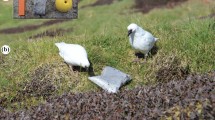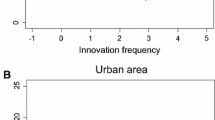Abstract
Individuals differ consistently in their behavioural reactions towards novel objects and new situations. Reaction to novelty is one part of a suit of individually consistent behaviours called coping strategies or personalities and is often summarised as bold or shy behaviour. Coping strategies could be particularly important for migrating birds exposed to novel environments on their journeys. We compared the average approach latencies to a novel object among migrants and residents in partially migratory blue tits Cyanistes caeruleus. In this test, we found migrating blue tits to have shorter approach latencies than had resident ones. Behavioural reactions to novelty can affect the readiness to migrate and short approach latency may have an adaptive value during migration. Individual behaviour towards novelty might be incorporated among the factors associated with migratory or resident behaviour in a partially migratory population.


Similar content being viewed by others
References
Able KP, Belthoff JR (1998) Rapid ‘evolution’ of migratory behaviour in the introduced house finch of eastern North America. Proc R Soc B 265:2063–2071
Benus RF, Koolhaas JM, Vanoortmerssen GA (1987) Individual differences in behavioral reaction to a changing environment in mice and rats. Behaviour 100:105–122
Brown C, Jones F, Braithwaite V (2005) In situ examination of boldness–shyness traits in the tropical poeciliid, Brachyraphis episcopi. Anim Behav 70:1003–1009
Dingemanse NJ, Both C, van Noordwijk AJ, Rutten AL, Drent PJ (2003) Natal dispersal and personalities in great tits (Parus major). Proc R Soc B 270:741–747
Drent PJ, van Oers K, van Noordwijk AJ (2003) Realized heritabilities of personalities in the great tit (Parus major). Proc R Soc B 270:45–51
Fraser DF, Gilliam JF, Daley MJ, Le AN, Skalski GT (2001) Explaining leptokurtic movement distributions: intrapopulation variation in boldness and exploration. Am Nat 158:124–135
Giles N, Huntingford FA (1984) Predation risk and inter-population variation in antipredator behavior in the three-spined stickleback Gasterosteus aculeatus. Anim Behav 32:264–275
Greenberg R, Mettke-Hofmann C (2001) Ecological aspects of neophobia and neophilia in birds. In: Nolan V, Thompson CF (eds) Current ornithology, Vol. 16. Kluwer Academic/Plenum Publishers, New York, pp 119–178
Heldbjerg H, Karlsson L (1997) Autumn migration of Blue tits Parus caeruleus at Falsterbo, Sweden 1980–94: population changes, migration patterns and recovery analysis. Ornis Svecica 7:149–167
Koolhaas JM, Korte SM, de Boer SF, van der Vegt BJ, van Reenen CG, Hopster H, de Jong IC, Ruis MAW, Blokhuis HJ (1999) Coping styles in animals: current status in behavior and stress-physiology. Neurosci Biobehav Rev 23:925–935
Mettke-Hofmann C (2007) Object exploration of garden and Sardinian warblers peaks in spring. Ethology 113:174–182
Mettke-Hofmann C, Greenberg R (2005) Behavioral and cognitive adaptations to long-distance migration. In: Greenberg R, Marra PP (eds) Birds of two worlds. The John Hopkins University Press, Baltimore, pp 114–123
Mettke-Hofmann C, Ebert C, Schmidt T, Steiger S, Stieb S (2005a) Personality traits in resident and migratory warbler species. Behaviour 142:1357–1375
Mettke-Hofmann C, Wink M, Winkler H, Leisler B (2005b) Exploration of environmental changes relates to lifestyle. Behav Ecol 16:247–254
Mettke-Hofmann C, Lorentzen S, Schlicht E, Schneider J, Werner F (2009) Spatial neophilia and spatial neophobia in resident and migratory warblers (Sylvia). Ethology 115:482–492
Nilsson ALK, Sandell MI (2009) Stress hormone dynamics: an adaptation to migration? Biol Lett 5(4):480–483
Nilsson ALK, Alerstam T, Nilsson J-Å (2006) Do partial and regular migrants differ in their responses to weather? Auk 123:537–547
Nilsson ALK, Alerstam T, Nilsson J-Å (2008) Diffuse, short and slow migration among blue tits. J Ornithol 149:365–373
Piersma T, Perez-Tris J, Mouritsen H, Bauchinger U, Bairlein F (2005) Is there a “migratory syndrome” common to all migrant birds? Ann NY Acad Sci 1046:282–293
Schwabl H (1983) Ausprägung und Bedeutung des Teilzugverhaltens einer südwestdeutschen Population der Amsel Turdus merula. J Ornithol 124:101–116
Sih A, Bell A, Johnson JC (2004) Behavioral syndromes: an ecological and evolutionary overview. Trends Ecol Evol 19:372–378
Sol D, Lefebvre L, Rodriguez-Teijeiro JD (2005) Brain size, innovative propensity and migratory behaviour in temperate Palaearctic birds. Proc R Soc B 272:1433–1441
Svensson L (1992) Identification guide to European passerines, 4th edn. Fingraf AB, Södertälje
Tulley JJ, Huntingford FA (1987) Paternal care and the development of adaptive variation in antipredator responses in sticklebacks. Anim Behav 35:1570–1572
van Oers K, Drent PJ, De Goede P, van Noordwijk AJ (2004) Realized heritability and repeatability of risk-taking behaviour in relation to avian personalities. Proc R Soc B 271:65–73
van Oers K, de Jong G, van Noordwijk AJ, Kempenaers B, Drent PJ (2005) Contribution of genetics to the study of animal personalities: a review of case studies. Behaviour 142:1185–1206
Verbeek MEM, Drent PJ, Wiepkema PR (1994) Consistent individual differences in early exploratory behavior of male great tits. Anim Behav 48:1113–1121
Verbeek MEM, Boon A, Drent PJ (1996) Exploration, aggressive behavior and dominance in pair-wise confrontations of juvenile male great tits. Behaviour 133:945–963
Verbeek MEM, De Goede P, Drent PJ, Wiepkema PR (1999) Individual behavioural characteristics and dominance in aviary groups of great tits. Behaviour 136:23–48
Wilson DS, Coleman K, Clark AB, Biederman L (1993) Shy-bold continuum in pumpkinseed sunfish (Lepomis gibbosus)—an ecological study of a psychological trait. J Comp Psychol 107:250–260
Acknowledgements
We would like to thank Sophie Ehnbom, Göran Walinder and Lennart Karlsson, among many others at Falsterbo Bird Observatory, and Martin Stjernman for help in the field. This is Report no. 256 from Falsterbo Bird Observatory. The work was performed under licenses from the Swedish Ethical Committee for Animal Experiments.
Author information
Authors and Affiliations
Corresponding author
Rights and permissions
About this article
Cite this article
Nilsson, A.L.K., Nilsson, JÅ., Alerstam, T. et al. Migratory and resident blue tits Cyanistes caeruleus differ in their reaction to a novel object. Naturwissenschaften 97, 981–985 (2010). https://doi.org/10.1007/s00114-010-0714-7
Received:
Revised:
Accepted:
Published:
Issue Date:
DOI: https://doi.org/10.1007/s00114-010-0714-7




